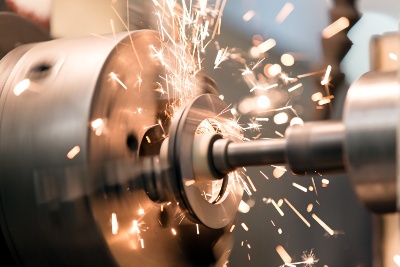Each Sunday, we publish a list of top articles and other content related to manufacturing in areas like quality control, product development, supply chain management, sourcing, auditing and law.
1. The tax attack on Chinese manufacturing
It’s pretty safe to say that manufacturing labor costs in China are lower than in Western countries. And although hourly manufacturing wages in China have grown at about 12 percent annually since 2001, the country is still a hot pick for making anything from cellphones to coffee makers to clothes. You name it, China probably makes it  somewhere.
somewhere.
But despite the prevalence of manufacturing in China, some feel the industry is hampered by a problem businessmen lament everywhere: taxes.
Specifically, Cao Dewang, the business tycoon and chairman of Fuyao Glass, thinks that the difference in the tax burden between China and America makes it more appealing to operate a business out of the former. Dewang said that,
…the overall tax on manufacturers is 35% higher in China than in America. Once China’s higher land and energy costs are factored in, the advantages of its lower labor costs disappear…
Dewang isn’t the owner of a small firm, however. He owns a major automotive glass company. His tax burden could certainly be much different from that of a smaller company, manufacturer or importer.
What do you think about the difference in taxation between the U.S. and China? Where is it more appealing to manufacture? Let us know in the comments section below!
If you’d like to read the full article on this topic, check it out on the Economist’s website by clicking the link below:
China’s Reputation for Low-cost Manufacturing under Attack – the Economist
2. Useful metrics to measure productivity
When looking out over a factory floor, it might seem as if there’s the right amount of activity. Goods are moving down conveyor belts at a breakneck pace. Workers are hardly ever idle. Shipments are going out left and right. But looks can be deceiving. The only way to really see through an illusion of productivity is to measure it.
As the author of this article mentions, three ways to measure productivity are to calculate shop-floor productivity, plant productivity and total operations productivity. I’ll mention the first of these three here.
Shop floor productivity = Overall Equipment Effectiveness (utilization X first pass yield X efficiency)
…or, if you don’t have OEE reporting in place,
Actual cost of production dollars current year vs. actual prior year cost of production dollars – adjusted for the new year's volume and product mix
Using this metric can help expose holes in factory reports that seem too good to be true. It also offers a way to reveal “issues on raw materials, quality cost issues, and labor cost issues.” And when trying to separate what works from what doesn’t, it’s this information that helps businesses make informed decisions.
If you’d like to learn about the other two metrics to measure productivity, check out the full article in the link below:
Performance Metrics that Matter: Effective Productivity Measures – Larry Fast, Industry Week
3. Mixing manufacturing methods for the future
Additive manufacturing is one technological advance that’s taken the spotlight in the world of manufacturing. The process’s remarkable ability to create things layer by layer with extreme precision poses tremendous opportunity to change the way countless goods are made. Yet the technology is still maturing.
 Subtractive manufacturing, by contrast, can’t always create the intricate designs additive manufacturing can. Sometimes, it’s more wasteful, too. But it’s still a reliable way to produce and is more cost effective and practical for certain items.
Subtractive manufacturing, by contrast, can’t always create the intricate designs additive manufacturing can. Sometimes, it’s more wasteful, too. But it’s still a reliable way to produce and is more cost effective and practical for certain items.
These methods, while fundamentally different, don’t have to be mutually exclusive. In fact, when they work together and complement each other’s strengths manufacturing ingenuity shines and better products are made.
The article mentions one example of this process collaboration already happening. The company Sodick has unveiled the OPM250L, which uses both metal 3D printing and high-speed milling to make products. By utilizing hybrid methodologies, no post-processing of items is required.
The “additive-first” approach of the machine allows products to be made with greater precision and density. With the benefits and integration that the OPM250L offers, it might be a good candidate for integration with the Internet of Things and for use in injection mold creation.
If you’re curious about other additive/subtractive hybrid technologies in the world of manufacturing, check out the article in the link below:
Additive Manufacturing Isn't the Whole Answer: Why Hybrid Technologies Are the Future of Manufacturing – Sarah Goehrke, 3Dprint.com
4. Lessons from the food industry for manufacturing
Let’s say you have several tiers of suppliers to make a bicycle. You’re aware that there are sub-suppliers in your supply chain and have acknowledged that they’re not detrimental to your business. That is until you need to issue a product recall for faulty brakes in your bikes and don’t know where the issue started and where you expect replacements.
Technology is increasingly able to help manufacturers avoid these types of problems. The article references the specific case of Hausbeck Pickle Co., a pickle business located in Michigan. Through investments in enterprise resource planning (see #3), the company is able to trace quality from the pickle plant all the way to stores.
The benefit here is not only for Hausebeck, but also consumers. If they want to know where a batch of product came from, they easily can. And in a world that increasingly demands supply train transparency, investing in measures to deliver it can help win consumer trust.
Monitoring quality is certainly different for food than non-consumable items. Companies that handle food can’t afford delays because they can literally render a product unsellable. There’s no need to consider the freshness of bikes, after all. But one principle remains the same for both product categories: investing in technology can keep your supply chain operating smoothly, get customers goods quicker and help avoid quality issues.
If you’d like to learn about some of the lessons the food industry can teach the rest of manufacturing, check out the full article in the link below:
Hungry for Data – Lauren Paul, Automation World
5. New graphene structure pushing manufacturing limits
Graphene is definitely a super manufacturing material. It’s the first 2D crystal known to man. It’s harder than diamond and 300 times stronger than steel. It can conduct electricity better than copper and is bendable. The list of benefits goes on. And thanks to the brilliant minds at MIT, this potential is being explored.
Researchers at MIT have taken small flakes of graphene and integrated them into a 3D mesh-like structure. The structure retains graphene’s strength and even allows it to be porous. Since the structure is 3D, it represents a step toward using graphene in large structures and objects.
Watch the video below to see the new graphene structure in action:
Thanks to this development, the 2D limitation posed by using graphene is slowly becoming a thing of the past. And when this technical hurdle is crossed completely, the world of manufacturing will be able to commercialize graphene and get lightweight, conductive and tough products to consumers everywhere.
If you’d like to learn more about what the researchers at MIT designed and the implications of their findings, check out the full article in the link below:
New 3D Graphene Structure Is Strongest and Lightest Material in the World – Aiden Burgess, the Manufacturer
We’re constantly scanning the web for top manufacturing stories and news. If you’d like to submit an article for consideration for our weekly Best in Manufacturing, send us a message and let us know.







